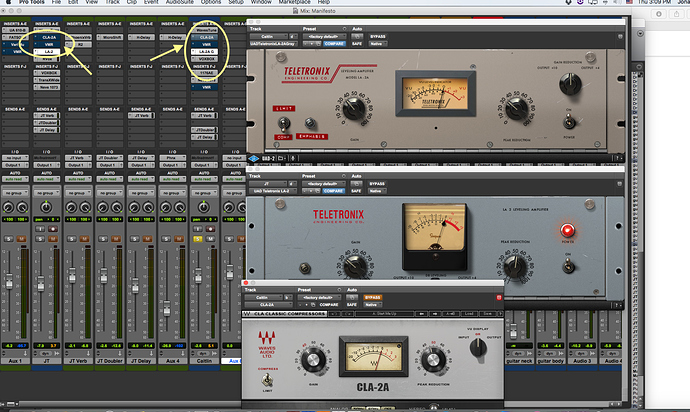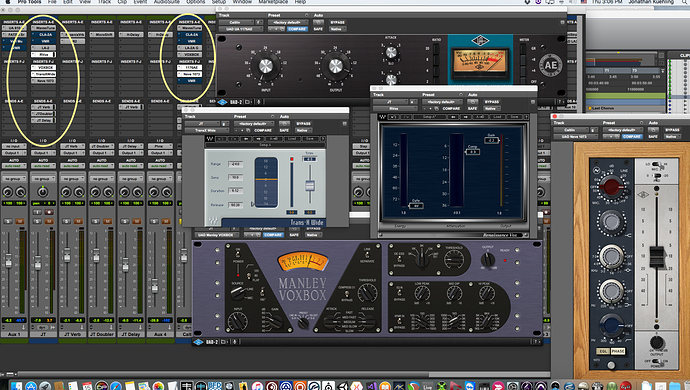I actually learned a new trick today… thought I’d share…As you’ll see, Mr Nevo is quite fond of compression, and not at all shy about using it. If you start the video from around 23 mins in you’ll catch on to a cool trick he does with a transient designer in his vocal chain - never seen that before… must try it the next time I’m using 30dB of GR on a vocal.
I frequently smash a lead vocal by 20 - 30db for exactly the reasons he states. Sounds like a bag o’ shite in solo but in the mix it gives clarity. Requires heavy de-essing and automation of (some) breaths.
I’m more interested in his room acoustics. How does that work then?
Thanks Andrew…for posting this. I agree that its a different use of the Trans X. Typically transient plugins, when placed behind a series of compressors, restore transients that the compressors have over-mashed. He seems to be using this one to subtract more transients, but in a very focused range. I was surprised to see this in combination in addition to the 2 dessert he already had on there. But at the end of his chain, he had very nice control over the tone and dynamic of the vocal.
His effects chain is worth noticing.
R-Desser -> LA2A -> R-chan -> R-Desser -> TransX -> Schoeps Neve 1073. Then he makes some subtle EQ moves on to brighten the upper mids.
What stood out to me is he got the bright clear cutting mid-range without being bombarded by sibilance. All the brightness and clarity was there, but it was controlled and glued. It was neat to watch how he accomplished this.
Here’s some other things I picked up on:
3:25 - Automation on the console vs automation ITB. He talks about how automation moves on the console can fight with automation movements in the DAW, particularly when compression is implemented post-DAW. The simplest solution is this:
-If the compressor is software ITB, switch it prefader
-If the compressor is outboard but on a DAW insert, then position the send/return prefader
-If the compressor is post DAW, automate the send/return to the compressor
-If your console does not have the option, move the compressor to a dedicated channel, then use a flying fader or VCA to control only the compressor.
5:50 calibrate meters - I can’t believe an SSL duality in a school classroom wasn’t calibrated? Why not just patch into the interface provided?
7:15 grouping stems - Why is he using 2 faders pr stereo channel, then making redundant EQ moves? So the Duality can not merge a stereo feed to a single fader? I think this is a distinct disadvantage of analog consoles. On hybrids like a Neve 88D, SSL C-300, Avid System 5, and Yamaha Nuage, you can aggregate an unlimited number of stereo stems, and on the Avid consoles, you also have a multi-mono option. But you can place them on one fader. This essentially DOUBLES the number of channels you can stack on your board at the same time.
15:00 Qclone - I’m questioning for 2 reasons…first, the ‘sound’ of the EQ isn’t merely the curve…Right? If this was the only factor, there wouldn’t be a difference between the sound of a console strip and a digital EQ. Second, why wouldn’t you just print the stem?
Noticed a wired USB mouse was plugged into a port on the side of the keyboard
That’s not his room, and those acoustics were sad. What a waste of a console and those monitors 
Looks like some classroom at a recording school like Full Sail.
Yeah, actually that was one of the reasons I posted this. I thought the transient designer might be a nice solution to these issues. I have yet to try it myself. I’ve watched a few other of his videos, and I’ve learned some and interesting approaches that I would never have thought of trying, or would even have though would work! He makes it work really well, though.
Yeah I noticed that too - terrible, boomy-sounding room… It’s definitely not his room - I think it’s the “Point Blank” classroom or whatever. This is his room - he has a Neve Console in it, not an SSL like in the video:
http://yoadnevo.com/recording-studio-london/
I really liked what he did with that - I was impressed with how it livened up that really crushed vocal.
Well, my guess is that, if they would put a console that costs as much as a house in a room that sounds that bad, all bets are off with those sorts of details.
Yeah, I didn’t quite get that part of it either… As far as I could understand, it had something to do with recall… I’d have to go and listen back again to fully understand it - I was watching it while I was on the rower doing some exercise, so I missed a few things.
Yep, definitely a school room of some kind, not a “proper” studio.
How much hands on have you had with the Slate Bomber? You can make this do what the trans-x does. That’s worth a try. Also, do you have the SPL transient designer, or the SPL Vitalizer unlocked in your UAD bundle? You may want to try the Vitalizer because your ‘tune’ knob allows you to isolate certain frequency ranges to mess with.
Dude…if you like that Waves 1073, unlock the v2 upgrades of the UAD neve 1073. I may as well have un-installed the Waves one. I haven’t touched it since. Honestly, I didn’t even like the way the 1073 sounded until I tried the UAD one lol.
Another trick if you want to crush a vocal is to throw a UAD LA-610 B in the same place, then turn the drive one click to the right. Then reduce your output to match the signal. I’ve been using this on my 9ft Baldwin D piano with the orchestra lately and it’s made that thing come alive! (Using Yamaha preamps and Earthworks mics).
hey Andrew, I just realized something…
I’m gonna try this in a sec…
R-Deseer -> LA2 (not LA2A) -> Manley Voxbox -> Manley Voxbox compressor -> Manley Voxbox compressor -> Trans X -> UAD 1073…
Exact same signal chain…I think one of the BIG things here is setting the LA-2/LA-2A infront of the R-channel. So he put a slow fat stubborn compressor at the front instead of the back, then reversed or inverted the Trans X to do the opposite of what it normally does.
Hey man, if you have a snippet of a vocal you want me to try it with, post a quick snippet of it, and I’ll run it through that chain for ya if you wanna hear it on any of your stuff! 
Hmmm. I’ve been playing with this. I don’t have the right type of vocal for this to work on. It is interesting though.
note to self, and to anyone else who messes around with this…Trans X setting are
Range -24
Sense 10
Duration 5.something
Release 65-80.something
So…the Trans X with the needle all the way at the bottom (-24) needs to have pretty specific duration and release settings. I did however find it to have a nice transparent effect on multiple vocals when they were in that range. Whole different story when you move the needle to the top (creating transients at +24). But I did like what was going on here.
I need a better vocal to try this with, and my hard drives are still boxed up 
More on this tomorrow!
Its been on my to-do list for a VERY long time, to start investigating some of these more up-to-date pop radio techniques. Especially in the vocals department.
Ok. I took another jab at this today. Yesterday, I mistakenly assumed the R channel was a generic channel strip. I never even use it. I went back and looked at his settings on the R channel, and realized there is an R-vox built in. THAT was a significantly large part of how Yoad got that bright wide modern sound he has here.
I had hoped this could be replicated with the Manley Voxbox, but it can’t. The reason is the twofold. First, because of how the unit is wired, the Voxbox compressor output is returned to the gain stage a second time on a feedback loop. The compressor on the voxbox is also a fixed 3:1, and its the wrong color tamber in the upper mids to replicate it. Second, the R-Vox is a really unique plugin. Like the Sonnox Inflator, no one really knows what it does, and there’s no other plugin on market like it.
So the Waves LA-2A at the front of the chain can be substituted for an 1176, a UAD LA2A, or anything that is slow, colorful and gritty. An API 2500 does not work on the front because its too clean. The Neve 33609 also does not work because its too dark. The Fairchild is slow and tube driven, but they won’t dirty up enough, and the Shadow Hills didn’t do well because its a dual stage compressor. The vintage DBX 160 actually had a sound that played really nice with the rest of the chain, but unfortunately, the release times are fixed and its too fast. Surprisingly (or maybe not surprisingly), the Tubetech CL1-B did work at the front of the chain.
I think if you really tried hard, a fabfilter Pro-C or a Voxengo plugin could work there, but to me, it seems much easier to pull a compressor with 2 or 3 knobs, then have to dial in the fabfilter and try to get it to act like a CL1B or an LA2A.
That 1073 at the end was much more important than you’d think it is. The waves one is adequate, though its never my first choice. The Slate 1073 got a passing grade too…it worked quite well. Even after the levels were matched and the settings were as close as I could get them, the UAD just had a different way of handling things. I would say the slate gave transparent, open, breathy clear finish. The UAD just plain sounded analog. I don’t know any other way of explaining it. I’m gonna keep messing with this chain, and I’ll post some audio very soon.
Long story short @ColdRoomStudio, that inverted transient designer isn’t doing as much as I thought it would. When I first watched it, I assumed the Trans-X was what was enabling the extreme settings on the compression to work. If you really liked this vocal sound (which I do), I think he combination of the R-vox (which is part of the R channel strip) and the 1073 are really what gave it that sound.

